Two bodies A and B of masses 5 kg and 10 kg in contact with each other rest on a table against a rigid wall . The coefficient of friction between the bodies and the table is 0.15. A force of 200 N is applied horizontally to A. What are (a) the reaction of the partition (b) the action-reaction forces between A and B ? What happens when the wall is removed? Does the answer to (b) change, when the bodies are in motion? Ignore the difference between μs and μk
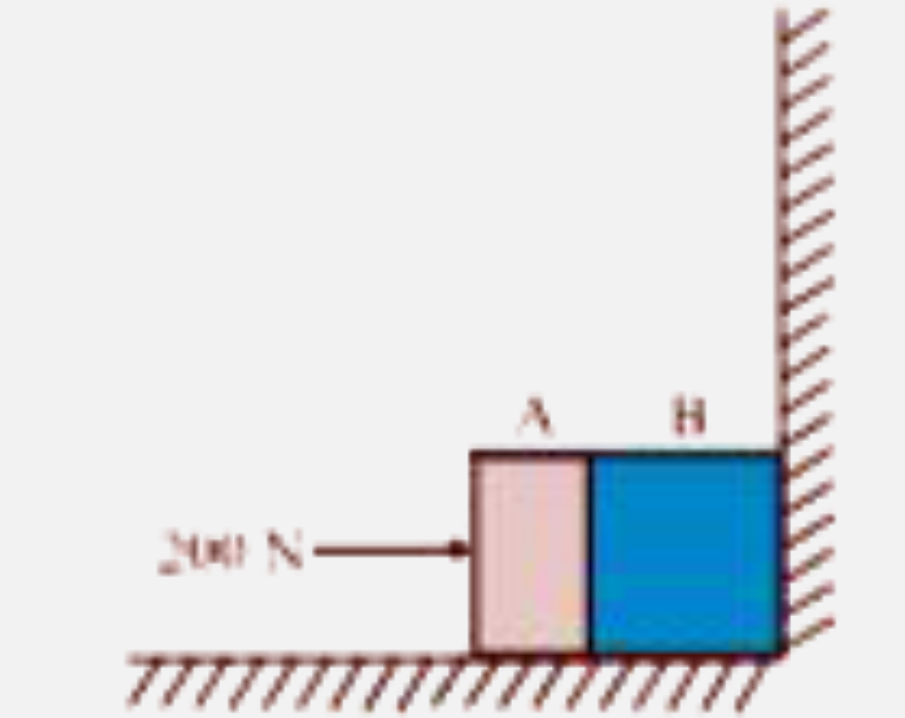 Solution in Tamil
Solution in Tamil
We assume perfect contact between bodies A and B and the rigid partition. In that case, the self-adjusting normal force on B by the partition (reaction) equals 200 N. There is no impending motion and no friction. The action-reaction forces between A and B are also 200 N. When the partition is removed, kinetic friction comes into play.
Acceleration of A+B=[200−(150×0.15)]/15=11.8ms−2
Friction on A=0.15×50=7.5N
200−7.5−FAB=5×11.8
FAB=1.3×102N , opposite to motion
FBA=1.3×102N , in the direction of motion
Topper's Solved these Questions
- LAW OF MOTIONBOOK - NCERT TAMILCHAPTER - LAW OF MOTIONEXERCISE - EXERCISE
23 Videos
- KINETIC THEORY OF GASESBOOK - NCERT TAMILCHAPTER - KINETIC THEORY OF GASESEXERCISE - EVALUATION (Numerical Problems)
8 Videos
- LAWS OF MOTIONBOOK - NCERT TAMILCHAPTER - LAWS OF MOTIONEXERCISE - EXERCISE (V. Numerical Problems)
14 Videos
Similar Questions
Give the magnitude and direction of the net force acting on
(a) a drop of rain falling down with a constant speed
(b) a crok of mass 10 g floating on water
(c) a kite skilfully held stationary in the sky
(d) a car moving with a constant velocity of 30kh/h on a rough road
(e) a high speed electron in space free from all gravitational objects and free of electric and magnetic fields.
View SolutionA fresh air is composed of nitrogen N2(78%) and oxygen O2(21%). Find the rms speed of N2 and O2 at 20∘C.
View SolutionA force of 50N act on the object of mass 20 kg. shown in the figure. Calculate the acceleration of the object in x and y directions
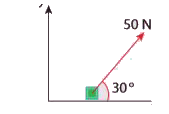
View SolutionA body of mass 2kg is at rest on a horizontal table. The coefficient of friction between the body and the table is 0.3 . A force of 5N is applied on the body. The acceleration of the body is.
View SolutionA body of mass 2 kg at rest on a horizontal table. The coefficient of friction between the body and the table is 0.3 . A force of 5N is applied on the body. The force of friction is
View SolutionTwo bodies A and B of mass 5 kg and 10 kg contact with each other rest on a table against a rigid The coefficient of friction between the bodies and the table is 0.05 A force of 200 N is applied horizontal on A What are (a) the reaction of thee wall (b) the the action , reaction forces between A & B ? What happens when the wall is removed ? Does the answer to (b) Change , when the bodies are in motion ? Ignore differnce between μs and μk
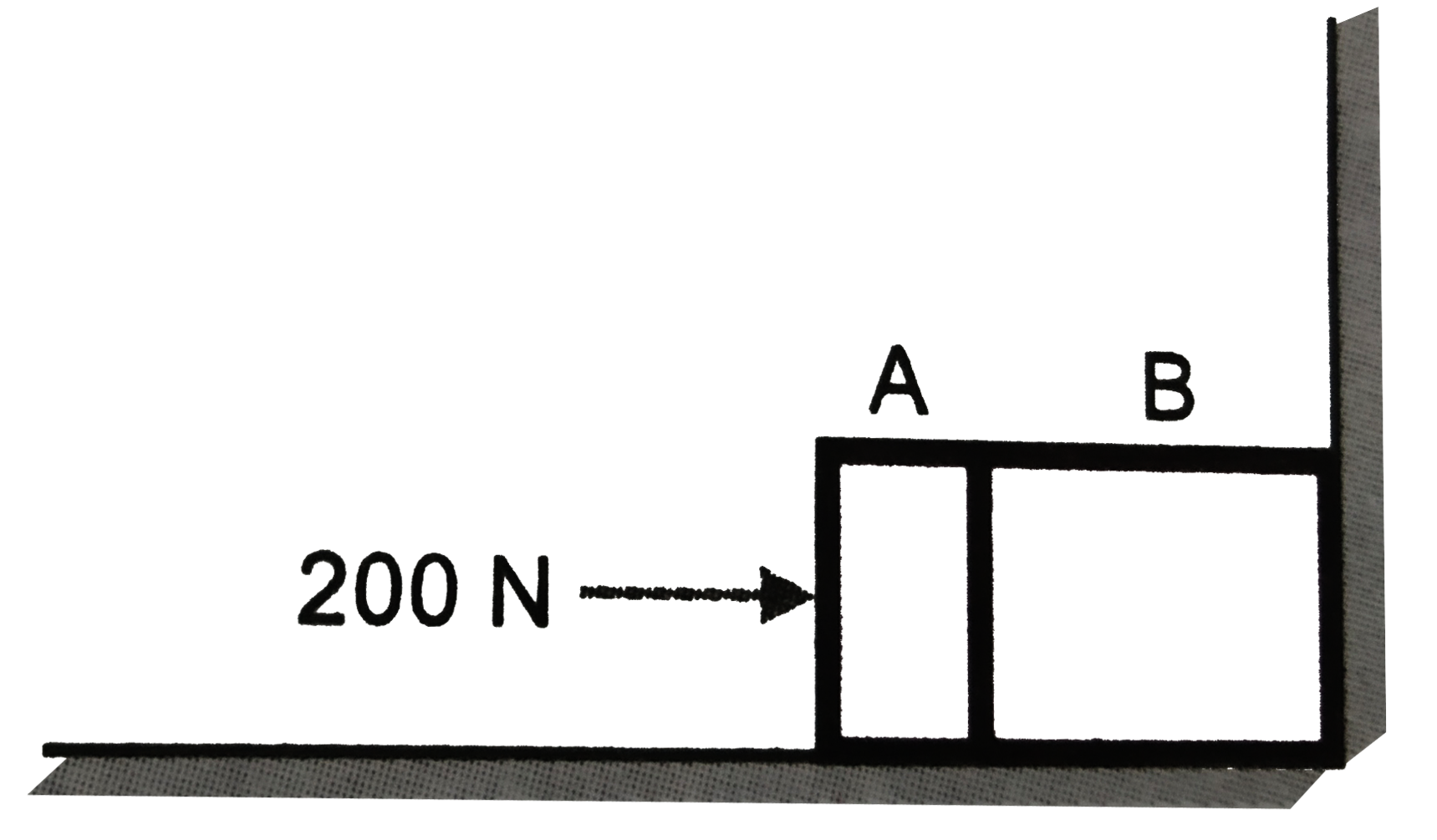 .
.
View SolutionTwo bodies A and B of mass 5 kg and 10 kg contact with each other rest on a table against a rigid The coefficient of friction between the bodies and the table is 0.15 A force of 200 N is applied horizontal on A What are (a) the reaction of thee wall (b) the the action , reaction forces between A & B ? What happens when the wall is removed ? Does the answer to (b) Change , when the bodies are in motion ? Ignore differnce between μs and μk
 .
.
View Solutionदो पिण्ड A तथा B जिनकी संहति क्रमशः 5 kg तथा 10 kg है, एक दूसरे के संपर्क में एक मेज पर किसी दृढ विभाजक दीवार के सामने विराम में रखे है (चित्र) पिण्डों तथा मेज के बीच घर्षण गुणांक 0.15 है। 200 N का कोई बल क्षैतिजत: A पर आरोपित किया जाता है। (a) विभाजक दीवार कि प्रतिक्रिया, तथा (b) A तथा B के बीच क्रिया-प्रतिक्रिया बल क्या है? विभाजक दीवार को हटाने पर क्या होता है? यदि पिण्ड गतिशील है तो क्या (b) का उत्तर बदल जाएगा ? μs तथा μk के बीच अंतर कि उपेक्षा कीजिए ।
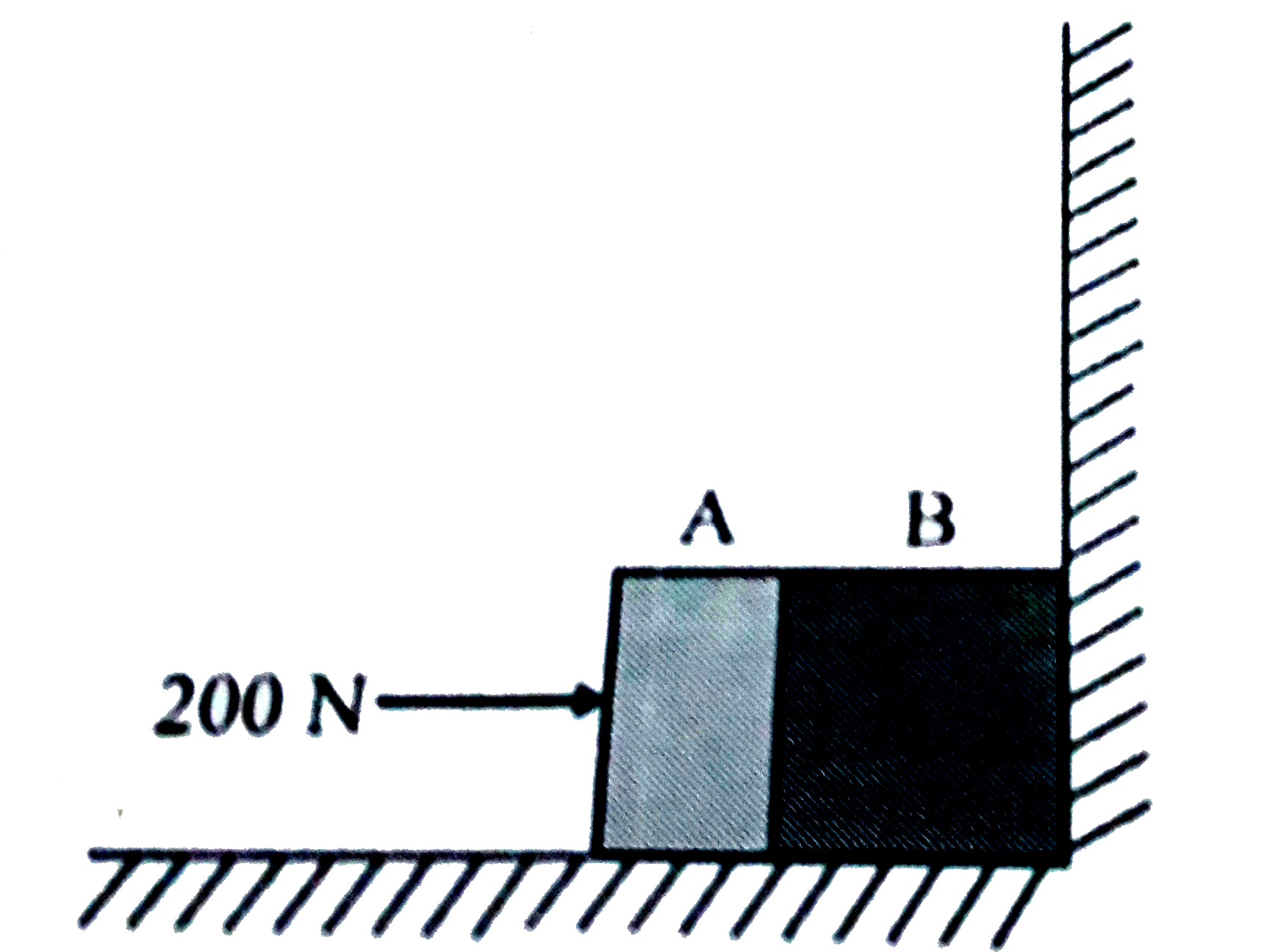
View Solutionदो पिंड A तथा B, जिनकी सहती क्रमशः 5 kg तथा 10 kg है, एक-दूसरे के समैक में एक मेज पर किसी दर्द विभाजक दीवार के सामने विराम में रखे है (चित्र) । पिंडों तथा मेज के बिच घर्षण गुणांक 0.15 है 200 N का कोई बल क्षेतिजतः A पर आरोपित किया जाता है (a) विभाजक दिवार की प्रतिक्रिया, तथा (b) A तथा बीके बिच क्रिया-प्रतिक्रिया बल क्या है ? विभ्कजक दिवार को हटाने पर क्या होता है यदि पिंड गतिशील है तो क्या (v ) का उतर बदल जायेगा ? μs तथा μk के बिच अंतर की अपेक्षा कीजिय |
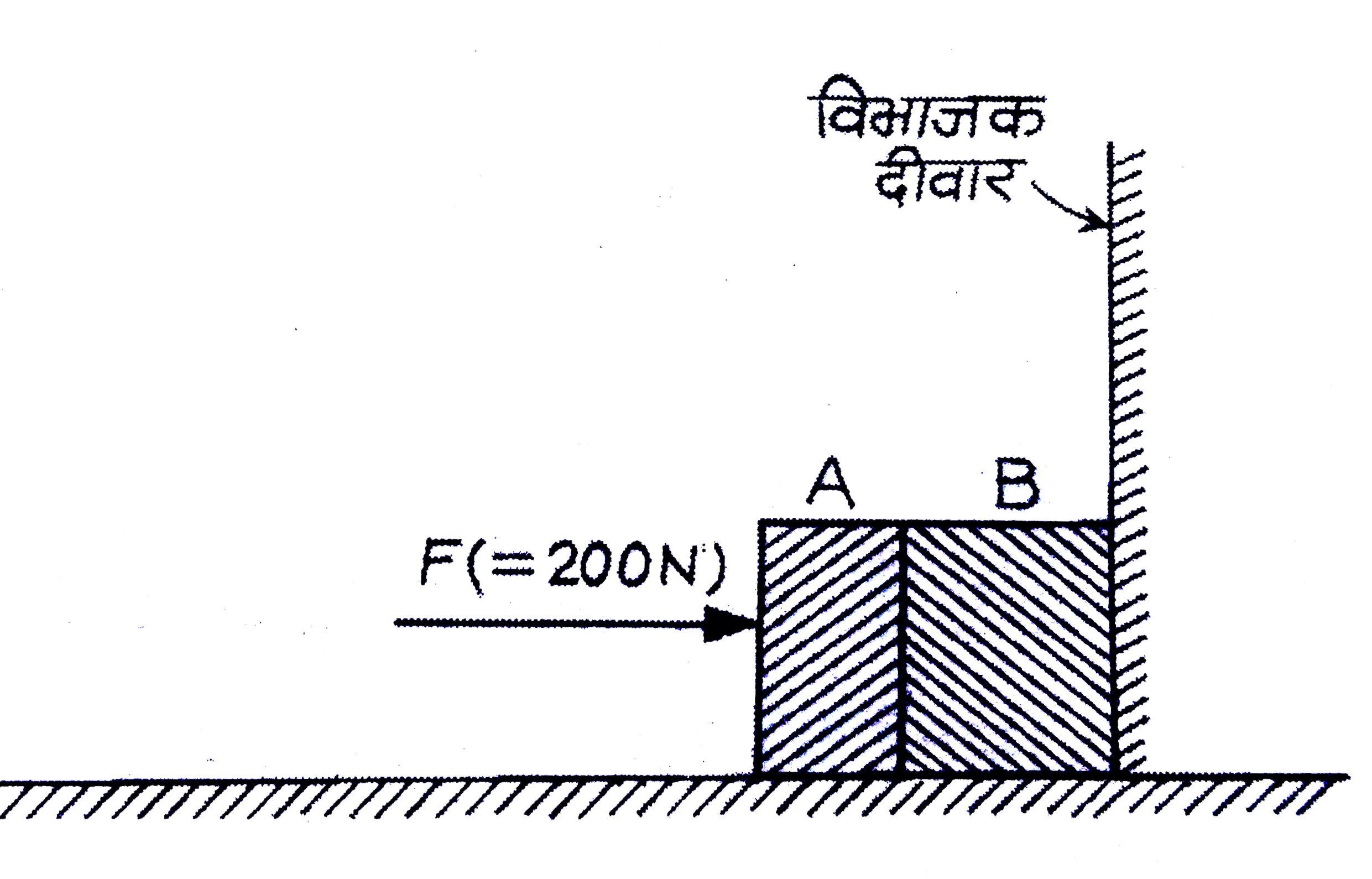
View SolutionTwo bodies A,B of masses 5 kg and 10 kg in contact with each other rest on a table against a rigid wall. The coefficient of friction between the bodies and the table is 0.15. A force of 200 N is applied horizontally to A. (i) What is the reaction of the partition? (ii) The actionreaction forces between A,B? (iii) What happens when the wall is removed ? Does the answer to (ii) change when bodies are in motion ? [ Ignore the difference between mu_(s) and mu_(k) ]
View SolutionTwo bodies A and B of masses 5 kg and 10 kg in contact with each other rest on a table against a rigid wall . The coefficient of friction between the bodies and the table is 0.15. A force of 200 N is applied horizontally to A. What are (a) the reaction of the partition (b) the action-reaction forces between A and B ? What happens when the wall is removed? Does the answer to (b) change, when the bodies are in motion? Ignore the difference between μs and μk
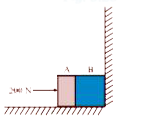
View SolutionTwo bodies A and B of masses 5 kg and 10 kg in contact with each other rest on a table against a rigid wall . The coefficient of friction between the bodies and the table is 0.15. A force of 200 N is applied horizontally to A. What are (a) the reaction of the partition (b) the action-reaction forces between A and B ? What happens when the wall is removed? Does the answer to (b) change, when the bodies are in motion? Ignore the difference between μs and μk
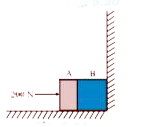
View SolutionTwo bodies A and B of masses 5 kg and 10 kg in contact with each other rest on a table against a rigid wall as shown in figure. The coefficient of friction between the bodies and the table is 0.15. A force of 200 N is applied horizontally to A. What are (a) the reaction of the partition, (b) The action-reaction forces between A and B ? What happens when the wall is removed ? Does the answer to (b) change, when the bodies are in motion ? Ignore the difference between p_(s) and p_(k) .
View Solution2 kg द्रव्यमान का एक गुटका (A), 8 kg द्रव्यमान के गुटके (B) जो कि क्षैतिज टेबल पर स्थिर है, पर रखा हुआ है (A) व (B) के मध्य घर्षण गुणांक 0.2 तथा (B) व टेबल के मध्य घर्षण गुणांक 0.5 है। 25 N का क्षैतिज बल (B) पर लगाया जाये तो (A) व (B) के मध्य घर्षण बल होगा :-
View SolutionTwo bodies A and B of masses 5 kg and 10 kg in contact with each other rest on a table against a rigid wall (Fig. 5.21). The coefficient of friction between the bodies and the table is 0.15. A force of 200 N is applied horizontally to A. What are :- the reaction of the partition.
View Solution
